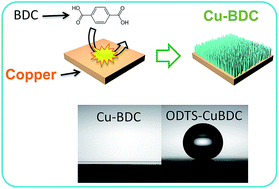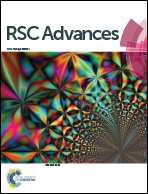Direct synthesis of Cu-BDC frameworks on a quartz crystal microresonator and their application to studies of n-hexane adsorption†
Abstract
We developed a facile route for synthesizing Cu-BDC frameworks using metallic copper as a metal ion source. A thin film of copper was vacuum deposited onto a quartz crystal microresonator (QCM) and converted to Cu-BDC frameworks via a solvothermal reaction. The initially superhydrophilic Cu-BDC surface became superhydrophobic upon being treated with octadecyltrichlorosilane (ODTS). Exposure of the Cu-BDC-coated quartz crystal microresonator (CuBDC-QCM) to various concentrations of n-hexane vapor induced changes in the resonance frequency and Q factor of the resonator that were related to the adsorbed mass of n-hexane and the modulus of the Cu-BDC layer, respectively. The mass of n-hexane vapor adsorbed on the superhydrophobic Cu-BDC layer was found to be three times that on the superhydrophilic Cu-BDC layer. Furthermore, the adsorption of n-hexane on the superhydrophobic Cu-BDC layer induced an increase in the modulus of the framework whereas the adsorption on the superhydrophilic layer induced a decrease in the modulus of the framework. These opposite changes were attributed to differences in the binding sites of n-hexane vapor inside the framework.


 Please wait while we load your content...
Please wait while we load your content...